Loading ...
Loading ...
Loading ...

9
ENGLISH
OPERATING INSTRUCTIONS
TESTING CONTINUITY & CABLE IDENTIFICATION SIMULTANEOUSLY – INSTALLED RJ45/RJ11/RJ12 CABLE
1. Attach a numbered Test + Map™ ID Remote to the RJ45/RJ12 port of each room that needs to be identified
using a known good patch cable‡. Write down the number of the remote and of the room number/description
in which it is placed for comparing/identifying the cables later.
2. Take the VDV Scout
TM
Pro 3 to the distribution point (often a wiring closet, switch or router at the other end of
the cable being tested).
3. Connect an unknown cable to the RJ45 port on the top of the tester.
4. Press the Data button
C
or Voice button
A
on the keypad to begin the test on the data or voice cable,
respectively. The LCD will display “ID#”, where “#” is the ID number of the Test + Map™ ID Remote connected
to the other side of the cable.
5. Compare this number to the remote number/room pair list you made in step 1 and mark the cable with a
piece of labeled tape, print a label or mark with permanent marker. The LCD will also display the results of the
continuity test. These results should be interpreted using the WIRING AND DISPLAY EXAMPLE section.
6. Repeat steps 4 and 5 for each unknown cable until all cables have been labeled. You can use these labels to determine
which rooms should be connected to the cable splitter, or to troubleshoot intermittent connections in the future.
‡NOTE: Only Klein Tools Universal RJ12 Jumper Cable (VDV726-125) or an approved equivalent should be used
in the RJ45 jack of the Test + Map™ ID Remotes. Using a standard RJ11/12 patch cable in the RJ45 port on the
tester could result in damaged contact pins.
TESTING CONTINUITY & CABLE IDENTIFICATION SIMULTANEOUSLY – INSTALLED COAX CABLE
1. Attach a numbered Test + Map™ ID Remote to the F-connector port of each room. Write down the number of
the remote and of the room number/description in which it is placed for comparing/identifying the cables later.
2. Take the VDV Scout
TM
Pro 3 to the distribution point (often a wiring closet, switch or router at the other end of
the cable being tested).
3. Connect an unknown cable to the Video port on top of the tester using a barrel connector.
4. Press the Video button
B
on the keypad to begin the test on the coax cable. The LCD will display “ID#” where
“#” is the D number of the Test + Map™ ID Remote connected to the other side of the cable.
5. Compare this number to the remote number/room pair list you made in step 1 and mark the cable with a piece
of labeled tape, print a label or mark with a permanent ink pen. The LCD will also display the results of the
continuity test. These results should be interpreted using the Wiring and Display Example section
6. Repeat steps 4 and 5 for each unknown cable until all have been labeled. You can use these labels to
determine which rooms should be connected to the cable splitter, or to troubleshoot intermittent connections
in the future.
HUB BLINK FUNCTION
1. Insert RJ45 terminated data cable into RJ45 port on top of tester, connect other end to equipment (hub, switch,
router, etc.).
2. Press power button
G
to turn on tester.
3. Long press (> 1 second) tone
D
button.
4. Signal will be transmitted from tester to equipment to illuminate corresponding port's light.
5. "HUB" will appear on the screen and blink at the same rate as the Hub Blink signal is being transmitted.
WIRE MAP AND DISPLAY EXAMPLES
NOTE: An open fault or short fault takes precedence
over miswires when the appropriate icon(s) illuminates.
The Split icon illuminates if the cable wiring does not
maintain the designated pairs, an AC signal fault.
PROPERLY WIRED T568A UTP:
Tester
Tester
Tester
Tester
Remote
Remote
Remote
Remote
1 2
3
4
5 6
7
8
ID
Pass
T568A SPLIT PAIRS:
T568A SHORT AND OPEN: T568A MISWIRE & UNRECOGNIZED CONTINUITY:
NOTE: Test + Map remote must be used for wire map testing.
8
1
FLASHING
Loading ...
Loading ...
Loading ...
